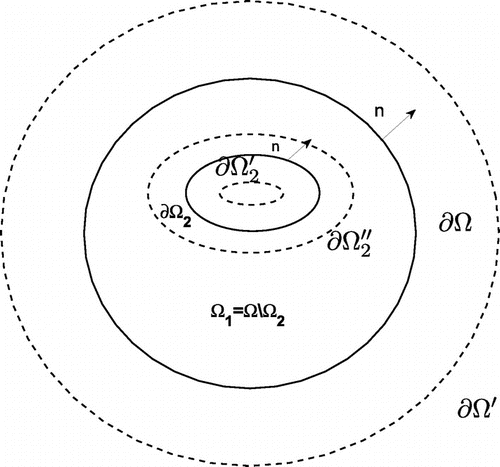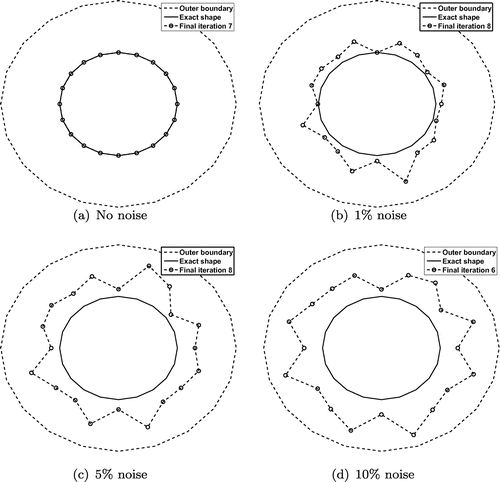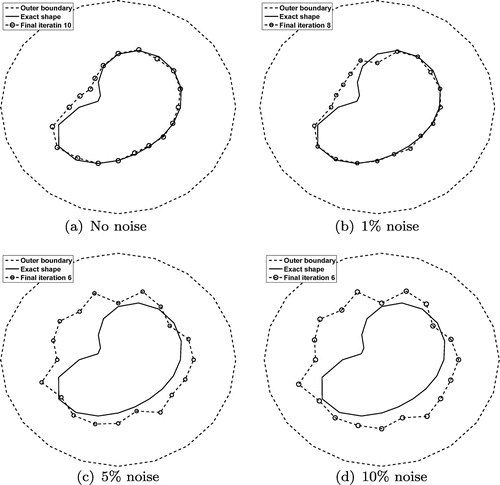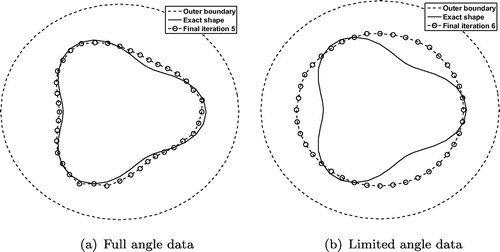 ?Mathematical formulae have been encoded as MathML and are displayed in this HTML version using MathJax in order to improve their display. Uncheck the box to turn MathJax off. This feature requires Javascript. Click on a formula to zoom.
?Mathematical formulae have been encoded as MathML and are displayed in this HTML version using MathJax in order to improve their display. Uncheck the box to turn MathJax off. This feature requires Javascript. Click on a formula to zoom.Abstract
In this paper, the inverse problem which consists of reconstructing an unknown inner boundary of a domain from a single pair of boundary Cauchy data associated to an elliptic equation is solved numerically using the meshless method of fundamental solutions. A nonlinear minimization of the objective function is regularized. The stability of the numerical results is investigated for several test examples with respect to noise in the input data and various values of the regularization parameters.
Introduction
The determination of an inhomogeneity (anomaly) contained in a given domain from the knowledge of the imposed voltage (boundary temperature) and the measured current (heat) flux arises in many non-destructive tomography testing of materials. In particular, in this paper, we consider the inverse problem of determining an inhomogeneity (with Lipschitz boundary
) compactly contained in a bounded domain
(with smooth boundary
) entering in the modified Helmholtz elliptic equation
(1)
(1) where
is a given positive function with
and of class
,
is the characteristic function of the domain
, and
is the potential (temperature). In heat transfer, Equation (Equation1
(1)
(1) ) stands as the governing equation for a (two-dimensional) dry fin-tube heat exchanger with
, where
is the thermal conductivity of the fin,
is the convective heat transfer coefficient and
is the fin thickness, see [Citation1]. By defining
(2)
(2) Equation (Equation1
(1)
(1) ) can be rewritten as the following transmission problem:
(3)
(3)
(4)
(4)
(5)
(5)
(6)
(6) where
denotes the outward unit normal to the boundary.
Associated to the above problem (Equation3(3)
(3) )–(Equation6
(6)
(6) ), we also have the Cauchy boundary conditions on
given by
(7)
(7)
(8)
(8) Such a problem arises in the determination of the contact resistivity of planar electronic devices.[Citation2] Other formulations of inverse obstacle problems can be found in the topical review by Isakov.[Citation3] Uniqueness of the inhomogeneity
entering the inverse problem (Equation3
(3)
(3) )–(Equation8
(8)
(8) ) has been established in the class of balls, star-shaped domains, convex hulls of polygons and other classes of subdomains in [Citation4–Citation7], respectively.
Recently, in [Citation8, Citation9] the authors determined inner rigid inclusions, cavities and absorbing obstacles in modified Helmholtz inverse geometric problems using the method of fundamental solutions (MFS). This method has proved rather versatile and easy to use for solving a wide range of inverse problems, see the recent review of Karageorghis et al. [Citation10]. In this study, we provide yet another application of the MFS for solving the inverse transmission problem (Equation3(3)
(3) )–(Equation8
(8)
(8) ).
The outline of this paper is as follows. In Section 2, we present the MFS for the modified Helmholtz equation in composite bi-materials. In Section 3, we present and discuss the numerically obtained results. In Section 4, we give some conclusions and possible future work.
The method of fundamental solutions (MFS)
In the MFS for a composite bi-material ,
, we approximate the solutions
and
of the modified Helmholtz Equations (Equation3
(3)
(3) ) and (Equation4
(4)
(4) ) by a linear combination of fundamental solutions in the form [Citation11],
(9)
(9)
(10)
(10) where
is the fundamental solution for the modified Helmholtz equations which in two dimensions, for example, is given by,
(11)
(11) where
is the modified Bessel function of the second kind of order zero. For simplicity, the constant
, which does not appear in (Equation11
(11)
(11) ), has been embedded in the unknown coefficients
in (Equation10
(10)
(10) ). The modified Bessel function
is computed using the NAG routine S18ACF. In the case that the background medium
is harmonic, i.e.
, we should replace
in (Equation9
(9)
(9) ) by the fundamental solution for the Laplace equation
(12)
(12) which in two dimensions is given by
(13)
(13) In this case, the MFS approximation for (Equation12
(12)
(12) ) is
(14)
(14) The source points
in (Equation9
(9)
(9) ) or (Equation14
(14)
(14) ) are located outside the domain
and inside the domain
, whilst the source points
in (Equation10
(10)
(10) ) are located outside
. More precisely,
and
are placed on (moving) pseudo-boundaries
and
similar to
at a distance
inwards and outwards, respectively. The rest of source points
are placed on a (fixed) pseudo-boundary
similar to
. A sketch of the fictitions curves
,
and
on which the source points are located is shown in Figure .
Fig. 4 The regularized objective function with various regularization parameters for
noise, as a function of the number of iterations, for Example 1.
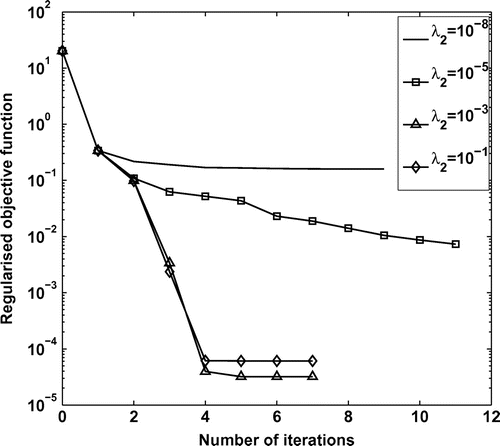
For simplicity, we assume that is the unit circle
and that the unknown domain
is star shaped with respect to the origin, i.e.
, where
is a
-periodic smooth function with values in the interval (0,1). We take
to be the outer boundary collocation points uniformly distributed on
, where
for
, and the source points
where
is fixed. We also take
(15)
(15) to be the inner unknown boundary collocation points on
, and the inner and outer source points
where
. In Equation (Equation15
(15)
(15) ),
for
.
The MFS coefficient vectors ,
in (Equation9
(9)
(9) ) or (Equation14
(14)
(14) ), and (Equation10
(10)
(10) ), and the radii vector
characterizing the star-shaped inner boundary
are determined by imposing the transmission conditions (Equation5
(5)
(5) ), (Equation6
(6)
(6) ) and the Cauchy data (Equation7
(7)
(7) ), (Equation8
(8)
(8) ) at the boundary collocation points
in a least-squares sense which recasts into minimizing the non-linear objective function
(16)
(16) where
are regularization parameters to be prescribed. Introducing the MFS approximations (Equation10
(10)
(10) ), and say (Equation14
(14)
(14) ) (with obvious modifications if (Equation9
(9)
(9) ) is used) into (Equation16
(16)
(16) ) yields
(17)
(17) The minimization of (Equation17
(17)
(17) ) imposes
non-linear equations in the
unknowns
. We can obviously have more equations than the unknowns if we take more boundary collocation points than sources. If there is noise in the measured data (Equation8
(8)
(8) ), we replace the exact
in (Equation17
(17)
(17) ) by the noisy
given by
(18)
(18) where
are random variables generated (using the NAG routine D05DDF) from a Gaussian normal distribution with mean zero and standard deviation
(19)
(19) where
represents the percentage of noise. In Equation (Equation17
(17)
(17) ), the normal derivatives of
and
, via (Equation12
(12)
(12) ) and (Equation11
(11)
(11) ), are given by
(20)
(20) where
is the modified Bessel function of the second kind of order one, and
(21)
(21) where
and
. The modified Bessel function
is computed using the NAG routine S18ADF. In Equation (Equation21
(21)
(21) ), the derivative
is approximated using backward finite differences as
(22)
(22) with the convention that
and
.
Fig. 5 The reconstructed inner boundary with various regularisation parameters for
noise, for Example 1.
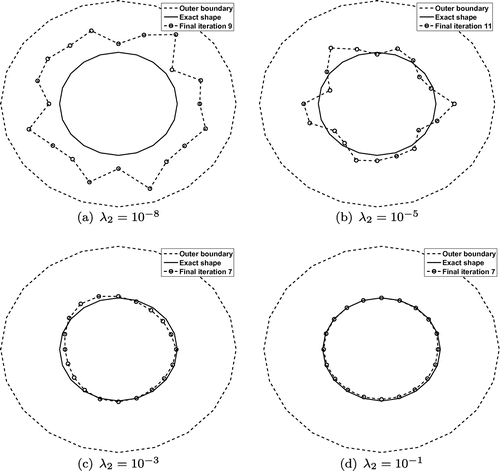
Fig. 6 The numerical solutions for the normal derivative , obtained for various values of
with (a) no regularisation, and (b) regularisation parameter
for the direct problem associated to Example 2.
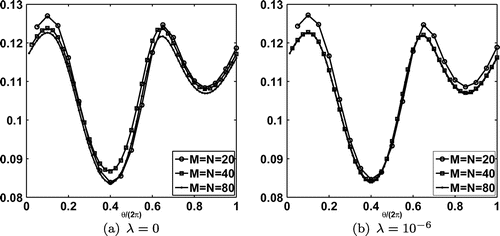
Fig. 7 The unregularized objective function for noise, as a function of the number of iterations, for Example 2.
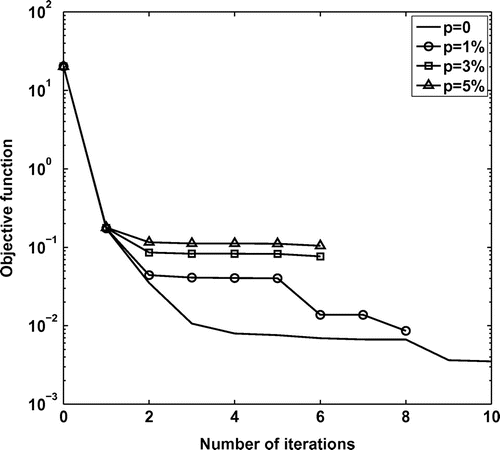
Fig. 9 The regularized objective function with various regularization parameters ,
for
noise, as a function of the number of iterations, for Example 2.
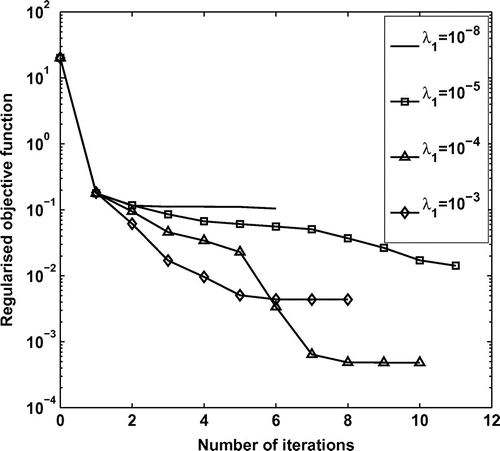
Fig. 10 The reconstructed inner boundary with various regularization parameters ,
for
noise, for Example 2.
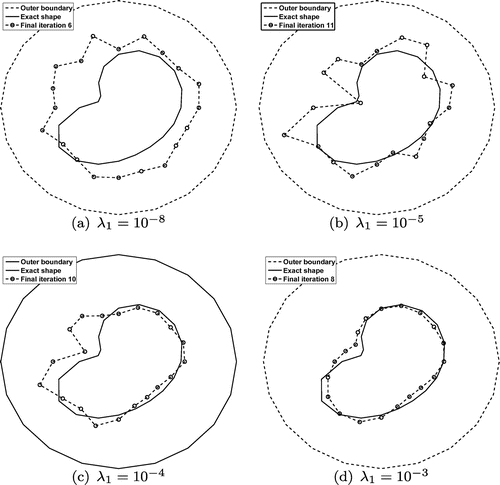
Fig. 11 The reconstructed inner boundary with various regularization parameters ,
for
noise, for Example 3.
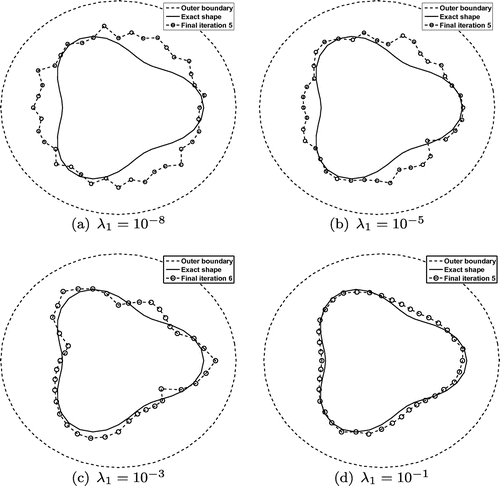
Fig. 12 The reconstructed inner boundary for (a) full angle data for , and (b) limited angle data for
, for no noise, for Example 3.
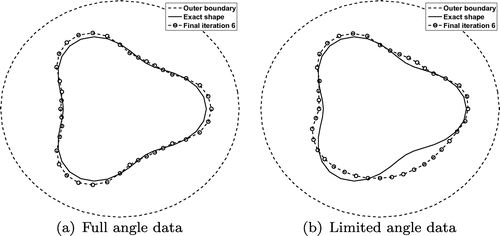
The minimization of the objective function (Equation17(17)
(17) ) is accomplished computationally using the NAG routine E04FCF, which is a comprehensive algorithm for minimizing an unconstrained sum of squares of nonlinear functions. Note that the NAG routine E04FCF does not require the user to supply the gradient of (Equation17
(17)
(17) ). If required, the physical constraints
for
, that the inhomogeneity
stays within the host domain
during the iteration proccess can be imposed manually during the iterative procedure by adjustment at each iteration. The minimization process usually terminates when either a user-specified tolerance is achieved, or when a user-specified maximum number of iterations is reached.
Numerical results and discussion
In this section, three examples in two dimensions are presented in order to show the accuracy and stability of the MFS described in the previous section.
We take and
. In all numerical experiments, the initial guess for the unknown vectors
,
are
and the initial guess for the inner boundary is taken to be a circle located at the origin with radius
, i.e. the initial guess for
is
. Moreover, as required by the NAG routine E04FCF used, the tolerance XTOL was set to
and the maximum number of function evaluations, MAXCAL, was set to 1000. However, it is noted that by increasing the MAXCAL to be large, say 400
(number of unknowns), as suggested by the NAG Fortran library manual, the computational time increases significantly and moreover, it does not produce more accurate numerical results. We also take
,
for examples 1 and 2, and
for example 3. Clearly, the rigorous choice of the regularization two-parameter family
and
in the nonlinear Tikhonov functional (Equation16
(16)
(16) ) is very challenging. One can attempt the usual discrepancy principle or the more recent L-surface criterion [Citation12] but the calculations are very expensive and close to being prohibitive. In our study, we have investigated by trial and error several values for
and
, and although we are not optimal in their difficult choice, at least we can discard the unstable solutions and provide some nearly optimal plausible stable candidates. Nevertheless, more work should be undertaken on the subject of multiple regularization in the future.
Example 1
We first consider an example for which the analytical solution is available and given by, see [Citation5],(23)
(23) where
,
(24)
(24) where
. The modified Bessel functions of the first kind of order 0 and 1, namely
and
are computed using the NAG routines S18AEF and S18AFF, respectively.
In this example, the unknown inner boundary is the disk(25)
(25) of radius
and
is taken to be 0.5. This analytical solution satisfies problem (Equation4
(4)
(4) )–(Equation8
(8)
(8) ) and (Equation12
(12)
(12) ), with
(26)
(26) and
(27)
(27) Figure shows the objective function (Equation17
(17)
(17) ) with no regularization, i.e.
, when
noise is added in the input data (Equation27
(27)
(27) ), as a function of the number of iterations. From this figure, it can be seen that the unregularized objective cost functional decreases rapidly within 6–8 iterations to either a very low value of
for
, or to a stationary level for
. Moreover, as expected, this level of stationarity decreases with decreasing the level of noise
.
In Figure , we present the reconstructed inner boundary and the exact shape (Equation25(25)
(25) ) with no regularization for
. As expected, as the level of noise increases, since no regularization is imposed, the reconstructed inner boundary becomes unstable.
Next, regularization is used in (Equation17(17)
(17) ) in order to stablize the numerical solutions. Figures and show the regularized objective function (Equation17
(17)
(17) ) and the reconstructed inner boundary, respectively, for
noise and various regularization parameters
,
. From Figure , it can be seen that accurate and stable numerical solutions are achieved for
and
in the range
to
, whilst clearly for
the obtained reconstructions become unstable.
Example 2
In the second example, we consider a more complicated bean-shaped inclusion given by the radial parameterization
(28)
(28) within the unit circle
. The Dirichlet data (Equation7
(7)
(7) ) on
is taken to be the same as in Example 1 and given by Equation (Equation26
(26)
(26) ). We also choose
.
Since in this case no analytical solution is available, the Neumann flux data (Equation8(8)
(8) ) on
is simulated numerically by solving, using the MFS, the direct problem given by Equations (Equation3
(3)
(3) )–(Equation6
(6)
(6) ) and (Equation26
(26)
(26) ), when
is known and given by (Equation28
(28)
(28) ). In this case, the numerical solutions for the normal derivative
on
, obtained for various values of
with no regularization
, and with regularization
are shown in Figure . From Figure it can be seen that the numerical results are convergent as the number of degrees of freedom increases. Furthermore, a small regularization with
tends to improve the independance of the mesh between
and
. Twenty evenly spread points out of the curve
with
of Figure are chosen as input Neumann numerically simulated data (Equation8
(8)
(8) ) in the inverse problem. Next, in order to avoid committing an inverse crime we solve the inverse problem with
.
Figures and for Example 2 are anologous to Figures and for Example 1 and the same conclusions about the unstable nature of the unregularized solution, as the level of noise increases, can be drawn. Figures and for Example 2 present similar characteristics to Figures and for Example 1. In order to investigate a different situation to that in Example 1 we regularize with
instead of
. From Figure , it can be seen that a stable and reasonably accurate numerical solution is obtained for
(and
), whilst clearly for
the obtained reconstructions become unstable.
Example 3
We finally consider reconstructing a complicated pear-shaped inclusion given by the radial parameterization
(29)
(29) within the unit circle
. The Dirichlet voltage (Equation2
(2)
(2) ) on
was taken to be the same as in Example 1 and given by Equation (Equation26
(26)
(26) ). We also take
. Since no analytical solution of this example is available, the Neumann flux data (Equation8
(8)
(8) ) on
is simulated numerically by solving the direct problem (Equation5
(5)
(5) )–(Equation8
(8)
(8) ) and (Equation26
(26)
(26) ), when
is known and given by (Equation29
(29)
(29) ), using the MFS with
and
. In order to avoid committing an inverse crime, we use a different number
in the inverse problem. Next, two cases are considered for this example, as follows.
Recovery from full angle data
We consider the first case when the full data of measurment of the flux on the outer boundary
is available. Figure shows reconstructed inner boundary with
, for various regularization parameters
,
. From this figure it can be seen that a stable and reasonably accurate numerical solution is obtained for
between
and
(and
).
Recovery from limited angle data
Finally, we consider the case of limited flux measurment data prescribed on the subportion
of the full outer boundary
. Figures and show the reconstructed inner boundary for both full and limited flux data with or without noise. From these figures it can be seen that, as expected, the reconstructed inner boundary from full angle data is much more accurate than that obtained from limited angle data.
Conclusions
In this paper, a novel numerical method based on a regularized iterative MFS has been developed for the reconstruction of an inhomogeneity in an inverse problem for the elliptic (modified Helmholtz) equation. The choice of the two-family multiple regularization parameters was based on trial and error. More rigorous choices of these parameters should be investigated in any future work. Several examples have been investigated showing that the MFS is accurate (for exact data) and stable (for noisy data). Future work will concern extending the MFS developed in this paper to the reconstruction of a source domain from Cauchy data.[Citation13]
Acknowledgments
B. Bin-Mohsin would like to thank King Saud University for their financial support in this research.
References
- Lin C-N, Jang J-Y. A two-dimensional fin efficiency analysis of combined heat and mass transfer in elliptic fins. Int. J. Heat Mass Transfer. 2002;45:3839–3847.
- Fang W, Cumberbatch E. Inverse problems for metal oxide semiconductor field-effect transistor contact resistivity. SIAM J. Appl. Math. 1992;52:699–709.
- Isakov V, Inverse obstacle problems, Inverse Probl. 2009;25:123002 (pp. 18).
- Kang H, Kwon K, Yun K. Recovery of an inhomogeneity in an elliptic equation. Inverse Probl. 2001;17:25–44.
- Hettlich F, Rundell W. Recovery of the support of a source term in an elliptic differential equation. Inverse Probl. 1997;13:959–976.
- Kim S, Yamamoto M. Uniqueness in identification of the support of a source term in an elliptic equation. SIAM J. Math. Anal. 2003;35:148–159.
- Kim S. Uniqueness determination of inhomogeneity in an elliptic equation. Inverse Probl. 2002;18:1325–1332.
- Bin-Mohsin B, Lesnic D. Determination of inner boundaries in modified Helmholtz inverse geometric problems using the method of fundamental solutions. Math. Comput. Simulation. 2012;82:1445–1458.
- Lesnic D, Bin-Mohsin B. Inverse shape and surface heat transfer coefficient identification. J. Comput. Appl. Math. 2012;236:1876–1891.
- Karageorghis A, Lesnic D, Marin L. Survey of applications of the MFS to inverse problems. Inverse Probl. Sci. Eng. 2011;19:309–336.
- Bin-Mohsin B, Lesnic D. The method of fundamental solutions for Helmholtz-type equations in composite materials. Comput. Math. Appl. 2011;62:4377–4390.
- Belge M, Kilmer ME, Miller EL. Efficient determination of multiple regularisation parameters in a generalized L-curve framework. Inverse Probl. 2002;18:1161–1183.
- Ikehata M. Reconstruction of a source domain from the Cauchy data. Inverse Probl. 1999;15:637–645.

